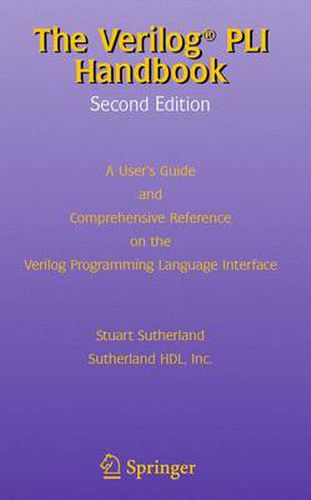Readings Newsletter
Become a Readings Member to make your shopping experience even easier.
Sign in or sign up for free!
You’re not far away from qualifying for FREE standard shipping within Australia
You’ve qualified for FREE standard shipping within Australia
The cart is loading…






This title is printed to order. This book may have been self-published. If so, we cannot guarantee the quality of the content. In the main most books will have gone through the editing process however some may not. We therefore suggest that you be aware of this before ordering this book. If in doubt check either the author or publisher’s details as we are unable to accept any returns unless they are faulty. Please contact us if you have any questions.
by Maq Mannan President and CEO, DSM Technologies Chairman of the IEEE 1364 Verilog Standards Group Past Chairman of Open Verilog International One of the major strengths of the Verilog language is the Programming Language Interface (PLI), which allows users and Verilog application developers to infinitely extend the capabilities of the Verilog language and the Verilog simulator. In fact, the overwhelming success of the Verilog language can be partly attributed to the exi- ence of its PLI. Using the PLI, add-on products, such as graphical waveform displays or pre and post simulation analysis tools, can be easily developed. These products can then be used with any Verilog simulator that supports the Verilog PLI. This ability to create thi- party add-on products for Verilog simulators has created new markets and provided the Verilog user base with multiple sources of software tools. Hardware design engineers can, and should, use the Verilog PLI to customize their Verilog simulation environment. A Company that designs graphics chips, for ex- ple, may wish to see the simulation results of a new design in some custom graphical display. The Verilog PLI makes it possible, and even trivial, to integrate custom so- ware, such as a graphical display program, into a Verilog simulator. The simulation results can then dynamically be displayed in the custom format during simulation. And, if the company uses Verilog simulators from multiple simulator vendors, this integrated graphical display will work with all the simulators.
$9.00 standard shipping within Australia
FREE standard shipping within Australia for orders over $100.00
Express & International shipping calculated at checkout
This title is printed to order. This book may have been self-published. If so, we cannot guarantee the quality of the content. In the main most books will have gone through the editing process however some may not. We therefore suggest that you be aware of this before ordering this book. If in doubt check either the author or publisher’s details as we are unable to accept any returns unless they are faulty. Please contact us if you have any questions.
by Maq Mannan President and CEO, DSM Technologies Chairman of the IEEE 1364 Verilog Standards Group Past Chairman of Open Verilog International One of the major strengths of the Verilog language is the Programming Language Interface (PLI), which allows users and Verilog application developers to infinitely extend the capabilities of the Verilog language and the Verilog simulator. In fact, the overwhelming success of the Verilog language can be partly attributed to the exi- ence of its PLI. Using the PLI, add-on products, such as graphical waveform displays or pre and post simulation analysis tools, can be easily developed. These products can then be used with any Verilog simulator that supports the Verilog PLI. This ability to create thi- party add-on products for Verilog simulators has created new markets and provided the Verilog user base with multiple sources of software tools. Hardware design engineers can, and should, use the Verilog PLI to customize their Verilog simulation environment. A Company that designs graphics chips, for ex- ple, may wish to see the simulation results of a new design in some custom graphical display. The Verilog PLI makes it possible, and even trivial, to integrate custom so- ware, such as a graphical display program, into a Verilog simulator. The simulation results can then dynamically be displayed in the custom format during simulation. And, if the company uses Verilog simulators from multiple simulator vendors, this integrated graphical display will work with all the simulators.